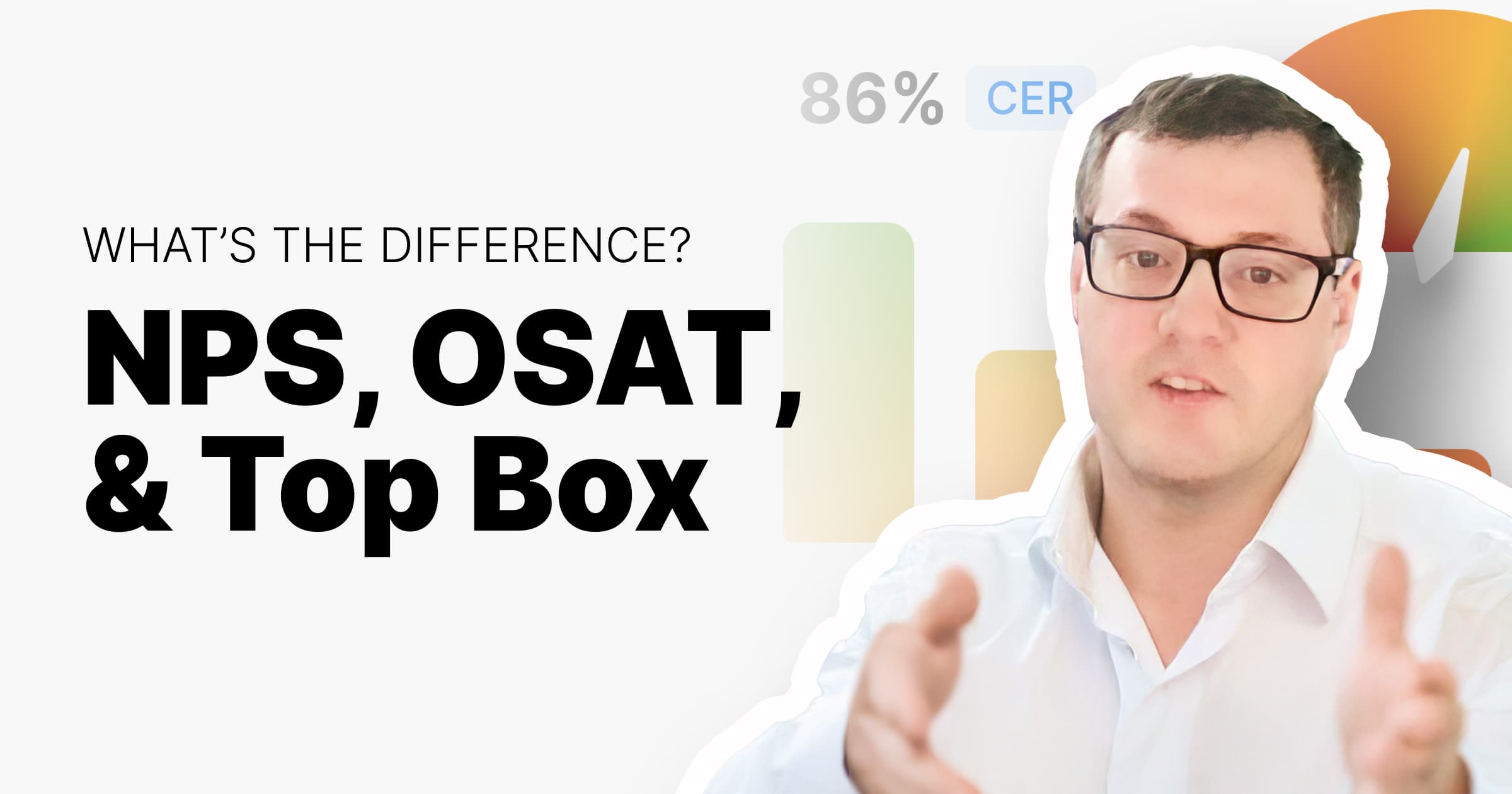Insights & Updates
Latest from Tattle
Discover trends, tips, and insights to elevate your restaurant operations.
Discover trends, tips, and insights to elevate your restaurant operations.


While there are various metrics to measure guest satisfaction, they serve different purposes based on your brand's goals. At Tattle, we’ve chosen to focus on Customer Experience Rating (CER) because it offers the most comprehensive and intuitive approach to understanding guest satisfaction.
But how does CER compare to other popular metrics like Net Promoter Score (NPS), Top Box, and Overall Satisfaction (OSAT)? Let’s break down the differences and help you understand which metric might be right for your operation.
Top Box measures the percentage of guests who rate their experience as perfect—5 stars on a 5-point scale or 9-10 on a 10-point scale. This metric removes all gray areas and focuses solely on exceptional experiences.
Best for:
Industry benchmark: 70% or higher is considered good performance
OSAT asks guests to rate their overall satisfaction on a scale (typically 1-5 or 1-7) and then calculates the average score across all responses. It’s essentially equivalent to CER but often uses different scale ranges. Some organizations calculate OSAT as the percentage of satisfied customers (similar to Top Box), while others use it as an average rating.
Best for:
Industry benchmark: 80%+ when calculated as percentage satisfied; 4.0+ when calculated as average rating
NSAT calculates the percentage of satisfied customers minus the percentage of dissatisfied customers, similar to NPS but using satisfaction rather than recommendation likelihood. It provides a net score that can range from -100% to +100%.
Best for:
Industry benchmark: 40%+ is considered good performance
NPS asks the fundamental question: “How likely are you to recommend this restaurant to a friend or colleague?” It categorizes responses into Promoters (9-10), Passives (7-8), and Detractors (0-6), with the final score calculated by subtracting the percentage of detractors from promoters.
Best for:
Industry benchmark: 50-60% is considered good performance
CER calculates the average star rating across all responses, similar to what guests see on Google, Yelp, or other review platforms. It gives proportional weight to all experiences—from 1-star disasters to 5-star victories.
Best for:
Industry benchmark: Mid to high 80s is typical for hospitality
Imagine two restaurants, each with 10 survey responses:
Restaurant A: 7 five-star reviews, 3 two-star reviews.
Restaurant B: 5 five-star reviews, 5 four-star reviews
Top Box results:
Restaurant A: 70% (7 out of 10 five-star responses) Restaurant B: 50% (5 out of 10 five-star responses)
Top Box suggests Restaurant A is performing better, but this metric completely ignores the severity of those three terrible experiences.
OSAT results (percentage satisfied – 4+ stars): Restaurant A: 70% (same as Top Box when using 4+ definition) Restaurant B: 100% (all responses were 4+ stars)
OSAT reveals a different story when including 4-star experiences as “satisfied.”
NSAT results (satisfied % – dissatisfied %): Restaurant A: 40% (70% satisfied – 30% dissatisfied) Restaurant B: 100% (100% satisfied – 0% dissatisfied)
NSAT shows the net satisfaction balance more clearly than raw percentages.
NPS results: Restaurant A: 40% (70% promoters – 30% detractors) Restaurant B: 50% (50% promoters – 0% detractors)
NPS reveals the full story—Restaurant A’s poor experiences create detractors who actively hurt the brand, while Restaurant B has no detractors at all.
CER results: Restaurant A: 3.4 out of 5 stars Restaurant B: 4.5 out of 5 stars
CER provides the most intuitive comparison, showing Restaurant B’s consistently good performance versus Restaurant A’s polarized experiences.
NPS throws away valuable data. Those 3-star “okay” experiences and 2-star “poor but not terrible” experiences receive zero consideration in NPS calculations. This means you’re losing insights about the middle ground where many guest experiences actually fall.
Top Box and traditional OSAT ignore the severity of dissatisfaction. A 4-star experience gets treated the same as a 1-star disaster in Top Box, when clearly these represent vastly different levels of guest satisfaction and recovery opportunities. Traditional OSAT (when calculated as percentage satisfied) has the same limitation.
NSAT provides balance but loses granularity. While NSAT captures the net satisfaction picture, it doesn’t show you the intensity of feelings or help you understand the specific experience quality distribution.
CER captures the full spectrum. Every star rating contributes proportionally to your score, giving you credit for decent experiences while still reflecting the impact of poor ones.
CER is the closest equivalent to your average rating on Google, Yelp, TripAdvisor, and other platforms where guests research restaurants. When your internal CER aligns with your public review scores, you have a consistent measurement system that helps you understand how private feedback relates to public perception.
A CER score of 87% feels achievable and motivating to restaurant managers. Compare this to:
CER scores naturally fall in ranges that feel intuitive to hospitality professionals, making it easier to set realistic goals and celebrate improvements.
While perfectionist metrics like Top Box might seem appealing, they can create an all-or-nothing mentality that doesn’t reflect real guest behavior. Research shows that receiving a 4 instead of a 5 on a satisfaction metric means anywhere from a 2x to 12x difference in likelihood to recommend, but this doesn’t mean 4-star experiences are worthless—they’re still positive interactions that contribute to your brand’s success.
CER provides granular insights that help you prioritize improvements:
The key question isn’t which metric is “best”—it’s which metric aligns with your brand’s goals and provides actionable insights for your team. Consider these factors:
Survey Volume: High-volume operations can afford the data loss inherent in Top Box and NPS. Lower-volume locations benefit from CER’s inclusive approach.
Brand Positioning: Fine dining establishments might prefer Top Box’s focus on perfection, while casual dining might prefer CER’s balanced approach.
Organizational Culture: Some teams thrive under the pressure of Top Box’s perfection standard, while others perform better with CER’s more forgiving but still challenging targets.
Integration Needs: If you’re actively managing your online reputation, CER’s alignment with review platform scores provides valuable consistency.
Understanding guest satisfaction metrics isn’t just about collecting numbers—it’s about choosing the right lens through which to view your operation’s performance. While Top Box and OSAT drive perfectionist thinking, NPS predicts loyalty, and NSAT shows satisfaction balance, CER provides the balanced, intuitive approach that works best for most hospitality brands.
At Tattle, we’ve chosen CER because it reflects the reality of guest experiences: they exist on a spectrum, every interaction matters, and improvement happens incrementally. When you can see your internal satisfaction scores align with your public review ratings, you have a powerful tool for driving real improvements in guest experience.
The metric you choose should empower your team to make better decisions, celebrate meaningful improvements, and ultimately create better experiences for your guests. In our experience, CER does exactly that.
Ready to implement CER in your operation? (https://get.tattleapp.com/book-a-meeting/) to learn how our guest experience platform can help you measure, understand, and improve satisfaction across all your locations.

About the Author
Intelligence & Analytics Expert
Alex formerly led Customer Excellence programs at Blaze Pizza and Dunkin'. Now, he oversees LTO testing, operational analysis, and ROI optimization for Tattle partners.